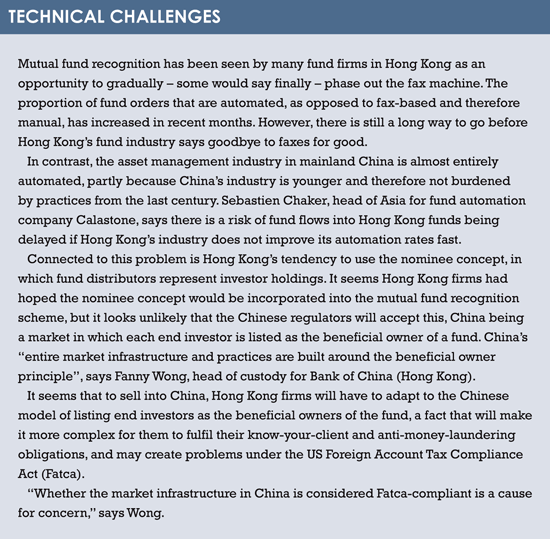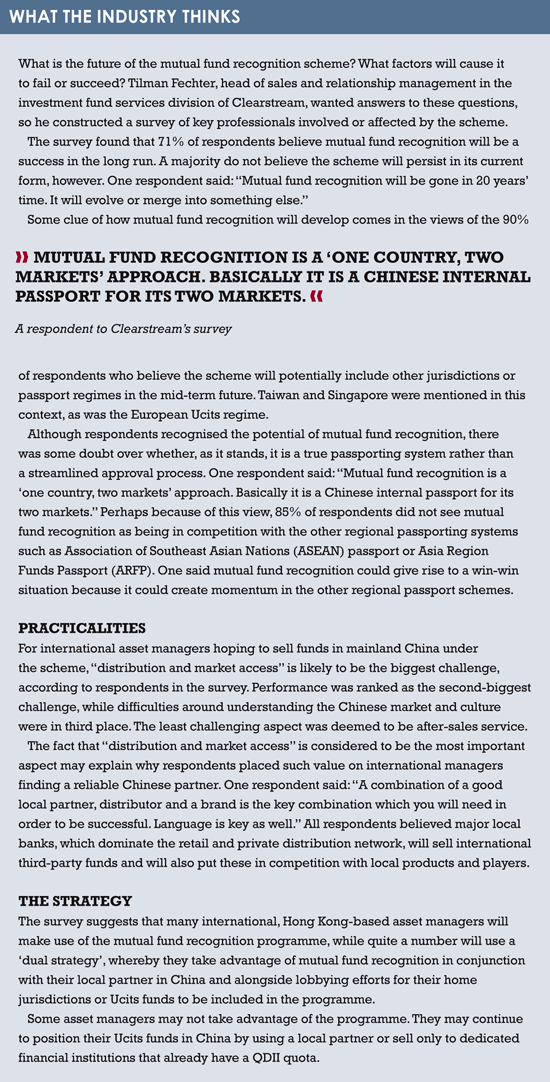Asset managers will soon be able to sell Hong Kong funds in mainland China and vice versa. What is the future of this scheme? George Mitton reports.
In August, the Chinese securities regulator released a list of the first funds it has accepted for review under the mutual fund recognition scheme. Amundi Hong Kong, Hang Seng Investment, Bank of China Hong Kong and Schroders were on the list, along with several others, with funds ranging from equity to bonds.
If their applications are successful, these firms will be able to sell their Hong Kong-domiciled funds in mainland China for the first time, opening up a potential customer base much larger than they could reach in Hong Kong. A number of Chinese mainland asset managers have applied under the scheme too, hoping to distribute their mainland-domiciled funds, for the first time, in Hong Kong.
What is the future of this scheme and how can asset managers make the most of it?
BENEFITS
Cross-border initiatives always generate interest from asset management firms, for good reason. A regulatory structure that allows an asset manager to distribute the same fund in multiple territories has the potential to dramatically increase investors in the fund while realising economies of scale and other cost savings. For this reason, the Ucits structure is regarded as an abiding success story.
For international firms, the mutual fund recognition scheme is especially appealing because it could allow them to reach what is perhaps the world’s most attractive market for investment products. Mainland China has a population of 1.4 billion people who save at a higher rate than people in the Western world and who are comparatively uninvested in investment products.
Mainland China is difficult for international firms to access, however. Until recently, their only option has been to establish a joint venture with a Chinese firm as majority partner. A few of these have been successful, but many have struggled, with reports of tension and culture clashes between the partners. (Recently, a new option has arisen: creating a wholly foreign-owned entity, or WFOE, in China – see our interview on pages 12-13 for more information.)
In contrast to the mainland, Hong Kong makes it easy for international firms to set up companies and register investment products. The appeal of mutual fund recognition is that it allows asset managers to set up funds in Hong Kong, where it is easy to do so, and sell them to China’s vast population. Senior executives at the aforementioned Hong Kong fund companies can be forgiven flutters of excitement as they imagine the billions of dollars that might conceivably come flowing into their funds from investors in Shanghai, Beijing and elsewhere.
 NEXT STEPS
NEXT STEPS
Will mutual fund recognition be as profitable for international asset managers as it sounds? Maybe, but there is much work to do in the meantime. One challenge to be overcome is technical. In Hong Kong, much of the asset management industry relies on manual processing of fund transfers, with many firms relying on fax machines. Automation rates have risen dramatically in the past year, largely in anticipation of mutual fund recognition. However, one major custodian bank in Hong Kong says roughly half its clients still rely on faxes for fund orders (see ‘Technical challenges’ box).
There are potential problems resulting from the scale of the Chinese market and uncertainty regarding demand. In mainland China, each investor is listed as a beneficial owner of a fund, unlike in Hong Kong, where a nominee, usually a fund distributor, represents investors’ holdings.
Some custodians in Hong Kong fear that registering the name of every mainland investor in a fund may create headaches for registrars in China, the main challenge being the difficulty of predicting how many investors are likely to sign up.
“Remember the surprise generated by Alibaba when they doubled the assets under management in China in three months, thanks to a money market fund?” says André Durand, managing director at SGSS Hong Kong. “They set up their fund and had the systems to face tremendous growth. They collected millions of investors in a short time frame. They managed to do that, but not everybody has the Alibaba capability.”
Of course, having too many potential investors to handle is a problem most asset managers dream of having, and it is likely most new entrants to the Chinese market will have the opposite problem – not enough investors. This scenario comes with its own downsides.“If you recruit too many operations people, you have a cost issue. If it’s not enough, your system implodes,” says Durand.
OBSTACLES
These technical challenges may seem minor in the long run, but they are indicative of a larger problem – uncertainty. No one really knows how much demand is in China for Hong Kong-domiciled funds.

The fund companies eagerly registering their products under the mutual fund recognition scheme hope it is a lot. Some, such as research firm Cerulli Associates, think it is a little.
Why so? According to Cerulli Associates, there is little reason to expect Hong Kong-domiciled funds under the mutual fund recognition scheme to do better in mainland China than the products of joint ventures already operating in China. These joint ventures “have struggled to consistently provide products and investment strategies that capture the interest of Chinese investors amid a very challenging distribution landscape”, says the firm.
There are several possible causes of the low popularity of foreign investment products in China so far. Some Chinese investors favour directly owning stocks than in investing via mutual funds; others prefer real assets such as property; another hypothesis is that investors are being sold their investment products through their retail banks, which generally are not promoting foreign products.
This may, of course, change. However, for Cerulli Associates, the lacklustre performance of Chinese joint ventures so far leads to a surprising conclusion: that it is mainland Chinese asset managers that will do best out of the mutual fund recognition scheme rather than Hong Kong ones.
At first glance, it seems odd to think mainland-domiciled funds can do better than Hong Kong-domiciled ones. The population of Hong Kong is just seven million, miniscule compared with 1.4 billion in China. It seems reasonable to think that with a smaller population, the potential inflows are smaller too.
On the other hand, Chinese mainland asset managers are well placed to market and distribute their products in Hong Kong. According to Cerulli Associates, all 20 of the mainland asset managers with the highest number of qualifying funds under the mutual recognition scheme have a subsidiary or a foreign partner in Hong Kong. The potential client base may be smaller, but the structure is in place to market and distribute funds and to raise money almost as soon as the funds qualify.
FUTURE
It remains to be seen whether mainland or Hong Kong managers do better out of mutual fund recognition. One thing the joint venture experience has shown is that it will not be easy to make money in China. International firms will have to earn those inflows, they will not happen by magic. This may mean large expenditures on marketing, or it may require partnerships with Chinese banks and distributors.
For mainland asset managers, the experience of distributing funds in Hong Kong will be an opportunity to extend their funds to new investors, and test their process and products in a cosmopolitan market with international standards. Those that do well in Hong Kong should be well placed to do well in other territories too.
Indeed, mutual fund recognition between mainland China and Hong Kong may well be stage one of a larger process. The next step could see recognition between mainland China and Singapore, or, perhaps, with Luxembourg or the UK. While international firms focus on getting investors in China, mainland Chinese firms are plotting a global expansion.
©2015 funds europe





